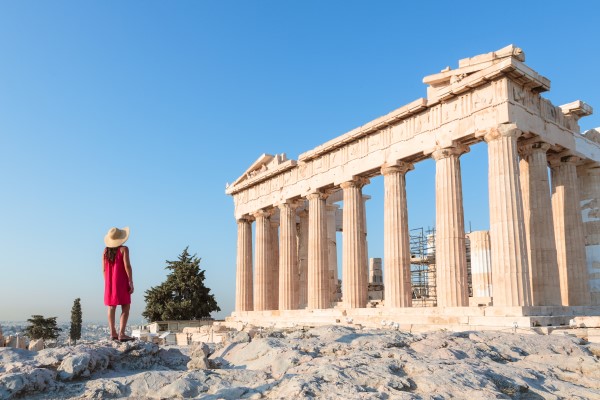Why travel to Greece?
For years, Australians have embraced Greek travel in droves - whether in search of ancient ruins, picturesque beaches or mouth-watering cuisine. Often regarded as the birthplace of Western civilisation, the idyllic vistas of Greece span across hundreds of islands and combine distinct cultural experiences with natural sights and wonders. Cruise the islands, hike along the coast or explore ruins that time left behind – a trip to Greece is a must for any keen traveller.
Five places to visit in Greece
No matter what time of year you choose to visit Greece, there’s always something incredible to discover. While most head to the islands in summer, winter could see you skiing on Mount Parnassus, wandering Naxos Town in spring or hiking around Crete in autumn. Here are our top five picks for the best places to visit in Greece and some of the sights to see while you’re there.
Mykonos
If – like many Australians travelling to Greece – you are in search of the party animal of the Cycladic islands, you’ll want to make your way to Mykonos. Regarded as Greece’s answer to Ibiza, you’ll find plenty of places to party at Paradise or Super Paradise beaches, where there’s no shortage of wild clubs and bars.
Prefer a more relaxed trip that also gives you time to take in the majesty of Mykonos? Head to the more relaxed Elia, a popular family beach, or discover the charming island capital of Hora.
Getting to Mykonos is easy, with regular ferries departing from Athens (Rafina and Piraeus ports) as well as neighbouring islands. If you want to turn a regular trip into a luxurious one, plan your trip to Greece during peak season and book one of the many high-speed catamarans that link Mykonos to other Cycladic islands.
Santorini
Paragraph: A name synonymous with unbridled beauty, Santorini is home to picture-perfect cliffside buildings, unmatched sunsets and volcanic-sand beaches. It’s no wonder 2 million tourists visit this island on their Greek travels each year.
Its cosmopolitan capital Fira is filled to the brim with upmarket hotels, award-winning restaurants, enviable terraces and untold photo opportunities at every turn. Further north sits Oia, a dreamscape of whitewashed houses carved into clifftops, providing a perfect spot to watch the sunset.
You can visit Santorini via ferries that depart from Piraeus (20 minutes by train outside Athens) and arrive at Athinios Port.
Athens
While there’s so much to see and do on your Greek travels, there’s no reason to flee the capital as soon as you touch down in Athens. Stay a while and you’ll be rewarded with a melting pot of diverse cultures, ancient history, urban chic and some of the most jaw-dropping architectural wonders of the world.
You are truly spoilt for choice in Athens, so start your morning by strolling through the old Ottoman quarter of Plaka, just beneath the Acropolis. Depending on your mood, a visit to the Acropolis Museum or the National Archaeological Museum might be on the cards, or head over to the city’s central market of Varvakios Agora. Finish your day with a smorgasbord of street snacks before immersing yourself in one of the many nightclubs, blues bars or jazz clubs dotted inside Athens’ beating heart.
Meteora
Stunning rock formations make Meteora one of the most visited destinations in all of the Mediterranean, but it’s the Byzantine monasteries sitting atop them that make this destination such a special part of a trip to Greece.
For James Bond connoisseurs, the Moni Agias Triados monastery – featured in For Your Eyes Only – is unmissable, while the largest monastery, Moni Megalou Meteorou, peers down at visitors and locals from more than 600 metres above. Top off your day of sightseeing by taking in the impossibly solitary Adhrakthi, a natural obelisk that steals the show as you stare up at the skyline from Kastraki Village.
Crete
Myth and legend were forged here on Crete. The birthplace of Greek twins Apollo and Artemis, Crete is the largest of the Greek islands, boasting sun-kissed beaches in the north and rugged canyons along its southern coast.
No trip to Greece is complete without a visit to the Palace of Knossos, a monumental symbol of Minoan civilisation. Or if you’d prefer to leave the sightseeing for another day, max out your adrenaline levels with bungee jumping, rock climbing or mountaineering in Chania.
Advice for Australians travelling to Greece
One of the most compelling reasons to take a trip to Greece is the gorgeous weather. This Mediterranean wonderland boasts sunshine throughout the year, although be aware that the northern parts of Greece can become very cold in the middle of winter. July and August are predictably busy months, but planning Greek travel during this period means you will also have access to more frequent ferry services between the islands.
The measles is common in Greece, so ensure your vaccinations are all up to date before departure. The West Nile virus (WNV) can also occur. As there is no vaccine for WNV, be sure to use insect repellent and check your accommodation is insect-proof. Private hospitals in Greece are expensive, and falling seriously ill or getting injured on an island could mean you are evacuated to Athens – so it’s recommended your travel insurance covers these potential outcomes.
Consider whether getting travel insurance for Greece will help protect you on your exciting Greek trip. Learn about Medibank Travel Insurance.


